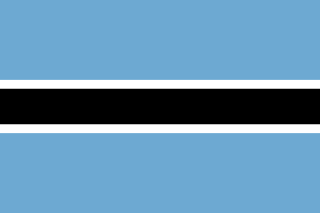Botswana - Geography

Here, let us take a look at the Geography of Botswana. Landlocked; sparsely populated with most settlement concentrated in the southern and eastern parts of the country; geography dominated by the Kalahari Desert, which covers about 70% of the country, although the Okavango Delta brings considerable biodiversity as one of the largest inland deltas in the World . Mother's mean age at first birth is (), whereas, the Maternal mortality ratio is 155 deaths/100,000 live births (2023 est.)
Geographical data of Botswana
| Location | Southern Africa, north of South Africa |
|---|---|
| Geographic coordinates | 22 00 S, 24 00 E |
| Map references | Africa |
| Tarrain | predominantly flat to gently rolling tableland; Kalahari Desert in southwest |
| Natural Resources | diamonds, copper, nickel, salt, soda ash, potash, coal, iron ore, silver |
| Natural Hazards | periodic droughts; seasonal August winds blow from the west, carrying sand and dust across the country, which can obscure visibility |
| Irrigated Land | 25 sq km (2014) |
| Major rivers (by length in km) | Zambezi (shared with Zambia [s]), Angola, Namibia, Zimbabwe, and Mozambique [m]) - 2,740 km; Limpopo (shared with South Africa [s], Zimbabwe, and Mozambique [m]) - 1,800 km; Okavango river mouth (shared with Angola [s], and Namibia) - 1,600 km |
| Major aquifers | Lower Kalahari-Stampriet Basin, Upper Kalahari-Cuvelai-Upper Zambezi Basin |
| Land Boundaries | 4,347.15 km |
| Border Countries | Namibia 1,544 km; South Africa 1,969 km; Zambia 0.15 km; Zimbabwe 834 km |
| Coastline | 0 km (landlocked) |
| Climate | semiarid; warm winters and hot summers |
| Area | |
| Total Area | |
| Land Area | 566,730 sq km |
| Water Area | 15,000 sq km |
| comparative Area | slightly smaller than Texas; almost four times the size of Illinois |
| Maritime Claims | |
| Elevations | |
| Highest point | Manyelanong Hill 1,495 m |
| Lowest point | junction of the Limpopo and Shashe Rivers 513 m |
| Mean elevation | 1,013 m |
| Land Use | |
| Agricultural land | 45.6% (2023 est.) |
| Agricultural land: arable land | arable land: 0.5% (2023 est.) |
| Agricultural land: permanent crops | permanent crops: 0% (2023 est.) |
| Agricultural land: permanent pasture | permanent pasture: 45.2% (2023 est.) |
| Forest | 27.8% (2023 est.) |
| Other | 26.6% (2023 est.) |
Population Distribution
The population is primarily concentrated in the east, with a focus in and around the capital of Gaborone and the eastern city of Francistown; population density remains low in other areas in the country, especially in the Kalahari Desert to the west.
People and Society
In Botswana, the different Ethnic groups are such that we have: Tswana (or Setswana) 79%, Kalanga 11%, Basarwa 3%, other, including Kgalagadi and people of European ancestry 7%
| Population | |
|---|---|
| Pop growth rate | 1.34% (2024 est.) |
| Birth rate | 19.6 births/1,000 population (2024 est.) |
| Death rate | 8.9 deaths/1,000 population (2024 est.) |
| Health expenditure | |
| Physicians Density | |
| Hospital bed Density | 2.2 beds/1,000 population (2021 est.) |
| Total fertility rate | 2.34 children born/woman (2024 est.) |
| Gross reproduction rate | 1.15 (2024 est.) |
| Contraceptive prevalence rate | |
| Est married women (ages 15-49) | 45% (2023 est.) |
| Literacy | |
| Education expenditures | |
| Net Migration rate | 2.7 migrant(s)/1,000 population (2024 est.) |
| Nationality | Motswana (singular), Batswana (plural) | Motswana (singular), Batswana (plural) |
| Languages | Setswana 77.3%, Sekalanga 7.4%, Shekgalagadi 3.4%, English (official) 2.8%, Zezuru/Shona 2%, Sesarwa 1.7%, Sembukushu 1.6%, Ndebele 1%, other 2.8% (2011 est.) |
| Religions | Christian 79.1%, Badimo 4.1%, other 1.4% (includes Baha'i, Hindu, Muslim, Rastafarian), none 15.2%, unspecified 0.3% (2011 est.) |
| Age Structure | |
| 0-14 years | 28.7% (male 355,583/female 348,863) |
| 15-64 years | 65.2% (male 759,210/female 837,752) |
| 65 years and over | 6.1% (2024 est.) (male 59,513/female 89,747) |
| Dependency Ratios | |
| Total dependency ratio | 53.5 (2024 est.) |
| Youth dependency ratio | 44.1 (2024 est.) |
| Elderly dependency ratio | 9.3 (2024 est.) |
| Potential support ratio | 10.7 (2024 est.) |
| Median Age | |
| Total | 27.1 years (2024 est.) |
| Male | 26 years |
| Female | 28.3 years |
| Urbanization | |
| Urban population | 72.9% of total population (2023) |
| Rate of urbanization | 2.47% annual rate of change (2020-25 est.) |
| Major urban areas (Pop) | 269,000 GABORONE (capital) (2018). |
| Sex Ratio | |
| At birth | 1.03 male(s)/female |
| 0-14 years | 1.02 male(s)/female |
| 15-64 years | 0.91 male(s)/female |
| 65 years and over | 0.66 male(s)/female |
| Total population | 0.92 male(s)/female (2024 est.) |
| Infant Motality | |
| Total | 23.7 deaths/1,000 live births (2024 est.) |
| Male | 25.9 deaths/1,000 live births |
| Female | 21.4 deaths/1,000 live births |
| Life Expectancy at birth | |
| Total population | 66.4 years (2024 est.) |
| Male | 64.4 years |
| Female | 68.6 years |
| Drinking Water Sources | |
| Improved: urban | urban: 97.5% of population (2022 est.) |
| Improved: rural | rural: 79.6% of population (2022 est.) |
| Improved: total | total: 92.6% of population (2022 est.) |
| Unimproved: urban | urban: 2.5% of population (2022 est.) |
| Unimproved: rural | rural: 20.4% of population (2022 est.) |
| Unimproved: total | total: 7.4% of population (2022 est.) |
| Sanitation facility acess | |
| Improved: urban | urban: 94.9% of population (2022 est.) |
| Improved: rural | rural: 63% of population (2022 est.) |
| Improved: total | total: 86% of population (2022 est.) |
| Unimproved: urban | urban: 5.1% of population (2022 est.) |
| Unimproved: rural | rural: 37% of population (2022 est.) |
| Unimproved: total | total: 14% of population (2022 est.) |
| Alcohol consumption per capita | |
| Total | 5.98 liters of pure alcohol (2019 est.) |
| Beer | 2.93 liters of pure alcohol (2019 est.) |
| Wine | 0.46 liters of pure alcohol (2019 est.) |
| Spirits | 0.96 liters of pure alcohol (2019 est.) |
| Other alcohols | 1.64 liters of pure alcohol (2019 est.) |
| Tobacco use | |
| Total | 17.1% (2025 est.) |
| Male | 29.2% (2025 est.) |
| Female | 5.5% (2025 est.) |
Demographic profile
All Important Facts about Botswana
Want to know more about Botswana? Check all different factbooks for Botswana below.









